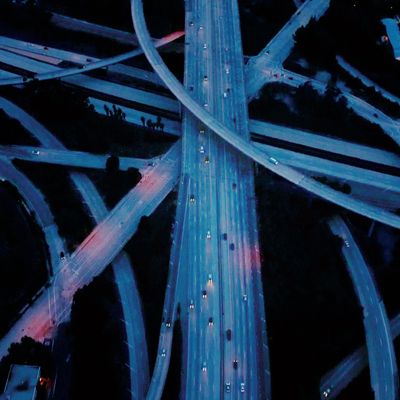
If you’ve been watching the second season of HBO’s True Detective, you’ve probably noticed how much time is spent in the sky. Not by the characters but by the camera — gliding over industrial barrens, hovering above traffic on California’s arterial tangles of highway. The diamond interchange that serves as the backdrop for the show’s title card — a photo by David Maisel — may be the season’s central image, in cold contrast to the lone tree of season one. Lizzie O’Leary of “Marketplace” even suggested a True Detective drinking game on Twitter: “Do a shot every time there’s a highway aerial. Surprise! You’re dead!”
“The aerials were written into the scripts from day one,” show creator Nic Pizzolatto says via email. “The idea was to highlight scale and connectivity; the big picture that informs these little lives.” Unlike season one, the current True Detective features multiple directors, so much of the responsibility for the visual style falls on the show’s director of photography, Nigel Bluck. He decided that, rather than a typical altitude of 200 to 500 feet, he would shoot from 1,000 feet — in part to amplify the abstract nature of the landscape, and in part because “we wanted a point of view that belongs to something bigger than us.”
Aerial shots have been a Hollywood staple since the beginning of the film industry: first via airplanes, then with the more versatile helicopter. There’s some debate over the first helicopter shot, though the film critic Nick Pinkerton traces it to Nicholas Ray’s 1948 film They Live by Night. In his recent consideration in Film Comment, Pinkerton writes, “The helicopter shot is, today, ubiquitous” and “a rank cliché.” When Hitchcock panned a cityscape in the opening shot of 1960’s Psycho, he was able to evoke a sense that evil lurked behind every half-pulled window shade. Soon, however, the hovering-copter shot became standard in every big-budget film; think of all the movies that start with a camera swooping over a city skyline. But, as Pinkerton writes, “I have not given up hope that the helicopter aerial shot may yet do new, great things for cinema.”
That day may have arrived. Aerial shots are much more accessible and versatile now, thanks to drones. The FAA cleared private drones for commercial use this past September, and they’re cheaper than helicopters, costing roughly $5,000 a day rather than the latter’s $15,000-to-$20,000 day rate.
Aesthetically, too, the aerial shot is transforming. Post-9/11 and post-NSA, the aerial imparts a new kind of unease, a more ambient dread. This new take is employed ingeniously by, for example, Christopher Nolan in 2008’s The Dark Knight, which opens on the Gotham cityscape over the sound of a ticking clock before we see a skyscraper window explode. What was once the filmmaker’s version of air supremacy now conveys pervasive vulnerability.
This, in part, informs the use of aerials in True Detective — as Bluck says, “There’s a sense of menace they can impose.” In this case, the menace comes from the landscape itself — the endless roadways that seem to promise progress but deliver its opposite. “With the freeways, you’re free to choose a direction but not free to choose your choices,” Pizzolatto explains, then adds, “But if that’s all nonsense, and it might be, I think they’re just interesting transitional shots.”
*This article appears in the July 13, 2015 issue of New York Magazine.

